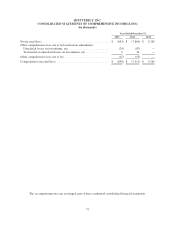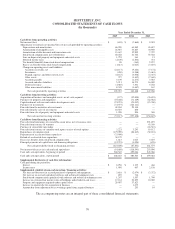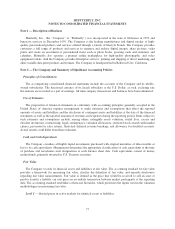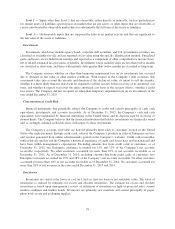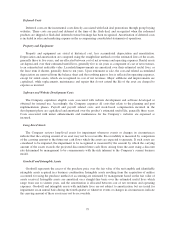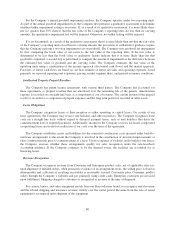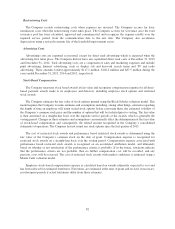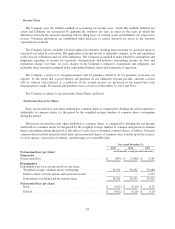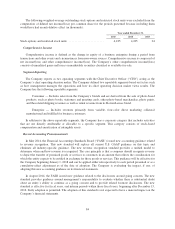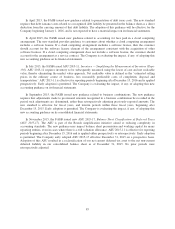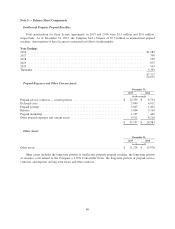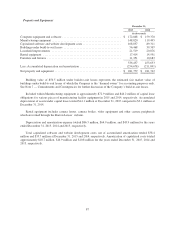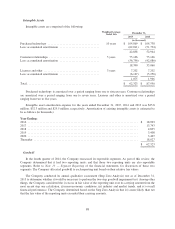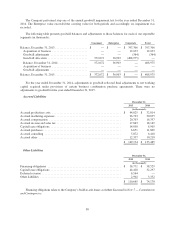Shutterfly 2015 Annual Report Download - page 87
Download and view the complete annual report
Please find page 87 of the 2015 Shutterfly annual report below. You can navigate through the pages in the report by either clicking on the pages listed below, or by using the keyword search tool below to find specific information within the annual report.In April 2015, the FASB issued new guidance related to presentation of debt issue costs. The new standard
requires that debt issuance costs related to a recognized debt liability be presented in the balance sheet as a direct
deduction from the carrying amount of that debt liability. The adoption of this guidance will be effective for the
Company beginning January 1, 2016, and is not expected to have a material impact on its financial statements.
In April 2015, the FASB issued new guidance related to accounting for fees paid in a cloud computing
arrangement. The new standard provides guidance to customers about whether a cloud computing arrangement
includes a software license. If a cloud computing arrangement includes a software license, then the customer
should account for the software license element of the arrangement consistent with the acquisition of other
software licenses. If a cloud computing arrangement does not include a software license, the customer should
account for the arrangement as a service contract. The Company is evaluating the impact, if any, of adopting this
new accounting guidance on its financial statements.
In July 2015, the FASB issued ASU 2015-11, Inventory — Simplifying the Measurement of Inventory (Topic
330). ASU 2015-11 requires inventory to be subsequently measured using the lower of cost and net realizable
value, thereby eliminating the market value approach. Net realizable value is defined as the “estimated selling
prices in the ordinary course of business, less reasonably predictable costs of completion, disposal and
transportation.” ASU 2015-11 is effective for reporting periods beginning after December 15, 2016 and is applied
prospectively. Early adoption is permitted. The Company is evaluating the impact, if any, of adopting this new
accounting guidance on its financial statements.
In September 2015, the FASB issued new guidance related to business combinations. The new guidance
requires that adjustments made to provisional amounts recognized in a business combination be recorded in the
period such adjustments are determined, rather than retrospectively adjusting previously reported amounts. The
new standard is effective for fiscal years, and interim periods within those fiscal years, beginning after
December 15, 2015. Early adoption is permitted. The Company is evaluating the impact, if any, of adopting this
new accounting guidance on its consolidated financial statements.
In November 2015, the FASB issued new ASU 2015-17, Balance Sheet Classification of Deferred Taxes
(ASU 2015-17). The ASU is part of the Boards simplification initiative aimed at reducing complexity in
accounting standards. The new guidance may impact balance sheet presentation and working capital for many
reporting entities, even in cases where there is a full valuation allowance. ASU 2015-11 is effective for reporting
periods beginning after December 15, 2016 and is applied either prospectively or retrospectively. Early adoption
is permitted. The Company early adopted ASU 2015-17 effective December 31, 2015 on a prospective basis.
Adoption of this ASU resulted in a reclassification of our net current deferred tax asset to the net non-current
deferred liability in our consolidated balance sheet as of December 31, 2015. No prior periods were
retrospectively adjusted.
85


